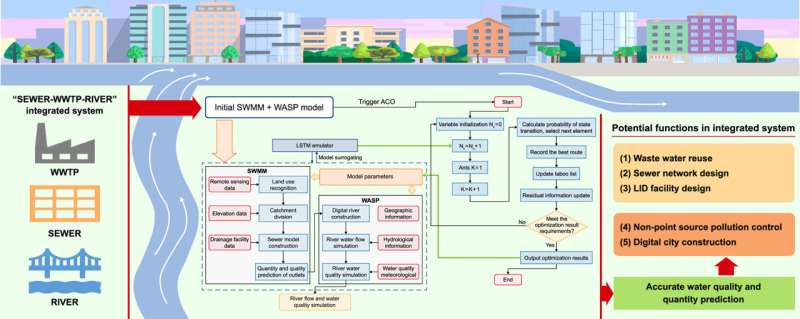This article has been reviewed according to Science X's editorial process and policies. Editors have highlighted the following attributes while ensuring the content's credibility:
fact-checked
proofread
How AI is clearing the waters in urban rivers

Researchers have developed a new machine learning system to improve the accuracy and efficiency of sewer-river system models. This innovative approach, detailed in an article published in Environmental Science and Ecotechnology, promises to significantly reduce parameter calibration time and enhance model precision in predicting urban water pollution.
The complexity of integrating sewer systems and urban rivers into a comprehensive model has long posed challenges due to extensive computational demands and limited monitoring data. Traditional calibration methods fall short in addressing these challenges effectively.
At the heart of this breakthrough research is the ingenious combination of two advanced technologies: Ant Colony Optimization (ACO) and Long Short-Term Memory (LSTM) networks, integrated into a machine learning parallel system (MLPS).
ACO is inspired by the foraging behavior of ants to find the most efficient paths, applied here to navigate through the complex parameter space of water models. Meanwhile, LSTM networks, a type of recurrent neural network, excel in recognizing patterns in sequential data, making them ideal for understanding the temporal dynamics of pollutants in sewer-river systems.
By marrying these technologies, the researchers have crafted an MLPS capable of performing rapid and precise calibrations of sewer-river models. Traditional methods, often cumbersome and time-consuming, can't match the efficiency or the accuracy of this new approach. Specifically, the MLPS drastically reduces calibration times from potentially months to just a few days, without sacrificing the model's ability to predict pollution levels accurately.
Dr. Yu Tian, lead author of the study, states, "The integration of Ant Colony Optimization and Long Short-Term Memory algorithms into our machine learning parallel system represents a significant leap forward in environmental management. It allows for rapid, accurate model calibration with limited data, opening new avenues for urban water system planning and pollution control."
MLPS offers a robust solution for the accurate simulation of urban water quality, essential for effective environmental management. Its ability to quickly adapt to new data and scenarios makes it a valuable tool for urban planners and environmental scientists, facilitating the development of targeted pollution control strategies and sustainable water management practices.
More information: Yundong Li et al, Machine learning parallel system for integrated process-model calibration and accuracy enhancement in sewer-river system, Environmental Science and Ecotechnology (2023). DOI: 10.1016/j.ese.2023.100320
Provided by TranSpread





















